This article will provide a comprehensive guide on setting up a commercial embroidery machine, covering the essential aspects from choosing the right machine to the necessary equipment and considerations for a successful embroidery operation.
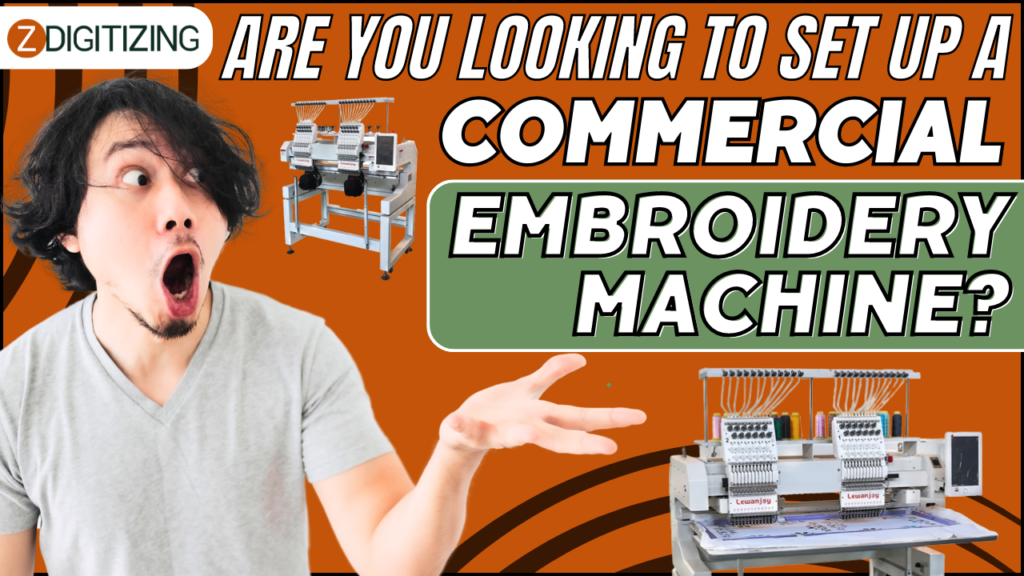
Are You Looking To Set Up A Commercial Embroidery Machine?
Selecting The Right Commercial Embroidery Machine:
Let’s see how can you select the right commercial embroidery machine.
Research different machine types:
Explore the various types of commercial embroidery machines available, such as single-head machines, multi-head machines, and combination machines, and determine which best suits your business needs and production requirements.
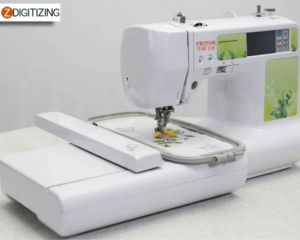
Consider features and capabilities:
Evaluate the machine’s features, including the number of needles, maximum stitching speed, hoop sizes, and compatibility with different file formats. Ensure that the machine has the necessary capabilities to handle the types of designs and projects you plan to undertake.
Preparing the Workspace:
Allocate sufficient space: Ensure you have enough space to accommodate the commercial embroidery machine, including additional room for hooping stations, thread storage, and workspace for operators.
Set up proper lighting and ventilation:
Adequate lighting is crucial for precision embroidery work. Additionally, ensure proper ventilation to maintain a comfortable and safe working environment.
Embroidery Digitizing
&
Vector Art Services
Are you looking for embroidery digitizing and vector art services at low cost with superfast turnaround, guaranteed quality and preview before pay? So, you are at right place. We can digitize and vectorize any type of artwork in your required file format.
Essential Equipment And Supplies:
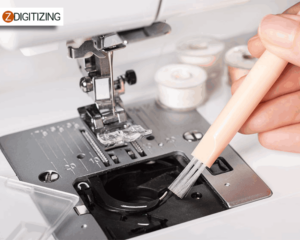
Hoops and frames:
Invest in a range of hoop sizes and frames to accommodate different garment sizes and embroidery requirements.
Stabilizers and backing materials:
Use appropriate stabilizers and backing materials to support the fabric during the embroidery process and prevent distortion.
Quality embroidery threads:
Choose high-quality embroidery threads in a variety of colors to achieve vibrant and durable designs.
Tools and accessories:
Stock up on essential tools like embroidery scissors, tweezers, and seam rippers, as well as accessories like bobbin winders and thread racks to streamline the embroidery workflow.
Digitizing And Preparing Designs:
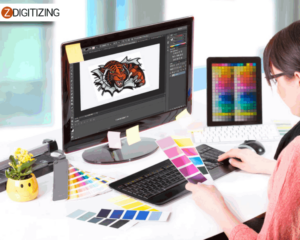
Digitizing embroidery software:
Invest in professional digitizing software to convert designs into machine-readable formats like DST or PES. Consider training or hiring skilled digitizers for more complex designs.
Design file optimization:
Optimize design files by reducing unnecessary stitches, adjusting stitch density, and ensuring proper thread color sequencing for efficient production and improved design quality.
Training And Operator Skill Development:
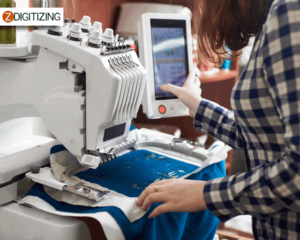
Operator training:
Provide comprehensive training for machine operators to ensure they are proficient in operating the commercial embroidery machine, changing threads, hooping garments, and troubleshooting common issues.
Ongoing skill development:
Encourage continuous learning and skill development for operators to stay updated with new techniques, design trends, and machine maintenance practices.
Workflow And Production
Workflow optimization:
Streamline the embroidery production process by establishing an organized workflow, from design approval and file transfer to hooping, stitching, and finishing.
Production scheduling:
Efficiently manage production schedules, considering factors like order volume, design complexity, and turnaround time to meet customer expectations.
Quality control measures:
Implement rigorous quality control procedures to ensure consistent embroidery results, including thorough inspections of finished garments and addressing any issues promptly.
Marketing And Business Considerations:
Building a portfolio:
Showcase a diverse range of embroidery samples and completed projects to attract potential customers and demonstrate your capabilities.
Pricing strategies:
Develop competitive pricing strategies based on factors such as design complexity, stitch count, and production time to ensure profitability while remaining competitive in the market.
Market research and targeting:
Identify target markets and customer segments to tailor marketing efforts and promotions effectively.
Maintenance And Machine Care:
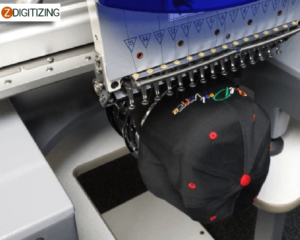
Regular Maintenance:
Establish a routine maintenance schedule to keep the commercial embroidery machine in optimal condition. This includes cleaning the machine, lubricating moving parts, and checking for any signs of wear or damage.
Troubleshooting Common Issues:
Train operators on troubleshooting common machine issues like thread breaks, tension problems, and needle breaks. Provide them with a comprehensive troubleshooting guide and ensure they are familiar with the machine’s manual.
Material Selection And Testing:
Test Embroidery On Different Fabrics:
Conduct sample tests on various fabrics to determine the best techniques and settings for optimal results. Different fabrics may require specific stabilizers, needles, or tension adjustments to achieve the desired outcome.
Explore Specialty Materials:
Consider expanding your offerings by exploring specialty materials like leather, denim, or performance fabrics that require specific embroidery techniques and considerations.
Expansion And Scalability:
Adding More Heads:
As your embroidery business grows, consider expanding your embroidery capacity by adding more embroidery machine heads. Multi-head machines allow for simultaneous production, reducing turnaround times and increasing productivity.
Automation And Digitization:
Explore automation options, such as automatic thread trimming or color change, to streamline the production process and increase efficiency. Additionally, consider integrating your embroidery machine with computerized systems for seamless design transfer and management.
Quality Assurance And Customer Satisfaction:
Sample Approval Process:
Implement a sample approval process with customers to ensure their expectations are met before proceeding with full production.
Feedback And Continuous Improvement:
Encourage customers to provide feedback on the quality of the embroidery and overall experience. Use this feedback to identify areas for improvement and enhance customer satisfaction.
Diversifying Product Offerings:
Embroidery On Various Items:
Explore opportunities beyond garments by offering embroidery services on accessories like hats, bags, towels, or patches. This expands your customer base and diversifies your product offerings.
Customization Options:
Provide customization options like monogramming, individual names, or personalized designs to cater to customers looking for unique and personalized embroidery.
Building Relationships And Networking:
Collaborations And Partnerships:
Forge collaborations with local businesses, designers, or event organizers to offer exclusive embroidery services or limited-edition collections.
Participating In Trade Shows And Exhibitions:
Showcase your embroidery capabilities and connect with potential customers by participating in industry trade shows, exhibitions, and craft fairs.
Keeping Up with Industry Trends:
Industry Research And Education:
Stay updated with the latest trends, techniques, and advancements in the embroidery industry through research, attending workshops, and participating in online forums or industry associations.
Innovation And Experimentation:
Encourage creativity and innovation within your embroidery business by experimenting with new materials, design techniques, or incorporating other embellishment methods like sequins or appliqués.
Conclusion:
Setting up a commercial embroidery machine requires careful consideration of various factors, from selecting the right machine to preparing the workspace, acquiring essential equipment and supplies, and optimizing the embroidery workflow. With the proper setup and attention to detail, businesses can embark on a successful embroidery operation, offering high-quality embroidered designs that meet customer expectations. By following this comprehensive guide, aspiring embroidery entrepreneurs can confidently embark on their journey in the world of commercial embroidery and leverage this versatile craft to create stunning and intricate designs on a variety of textiles.
We hope this article would be helpful for you. If you want to digitize embroidery design you would need a professional like ZDigitizing, as digitizing is a complex process.
Zdigitizing is a digitizing embroidery company that provides complete digitizing and vector art services all over the world to businesses, industries, and corporations. Zdigitizing provides high-class, durable, and reasonable custom digitizing embroidery and vector art services. We have been delivering top-notch digitizing embroidery services for 20+ years.
So, if you need a digitizing or vector art service for your embroidery machine, with a super-fast turnaround and excellent quality, ZD will be your best choice. Just click the link below and get a free quote in less than 5 minutes. We offer 50% off on all our services to our potential customers.
Hope it will be helpful for you guys!
If there’s any question related to this article you can simply ask in the comment section and don’t forget to share with those you think might be helpful for them.
And finally, thanks for reading!
Frequently Asked Questions
These are some of the best embroidery machines for commercial use:
- Brother SE1900
- Brother SE600
- Bernette B79
- Janome MB-7 Seven-Needle
- Juki Tajima SAI 8 Needle
Commercial machines come with all those fancy stitches, whereas on the other hand industrial machines generally only have one or two stitches. As a huge plus for the Commercial machine options, they don’t need cleaning. Industrial machines needs daily cleaning and oiling, so not maintaining the machine is generally a decision-maker.
These are some of the top six best commercial-grade embroidery machines:
- Ricoma CHT2 Series Multi-head Embroidery Machine:
- EMT16 PLUS Multi Needle Embroidery Machine:
- Tajima TMAR-V1512C Embroidery Machine:
- Brother PR1050X:
- Melco EMT16X Single/Multi-head Embroidery Machine:
- Happy’s multi-head Embroidery Machine:












